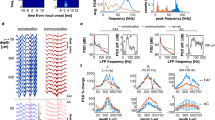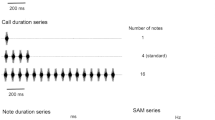Summary
1. The functional role of brainstem structures in the emission of echolocation calls was investigated in the rufous horseshoe bat, Rhinolophus rouxi, with electrical low-current microstimulation procedures. 2. Vocalizations without temporal and/or spectral distortions could be consistently elicited at low threshold currents (typically below 10 μA) within three clearly circumscribed brainstem areas, namely, the deep layers and ventral parts of the intermediate layers of the superior colliculus (SC), the deep mesencephalic nucleus (NMP) in the dorsal and lateral midbrain reticular formation and in a distinct area medial to the rostral parts of the dorsal nucleus of the lateral lemniscus. The mean latencies in the three vocal areas between the start of the electrical stimulus and the elicited vocalizations were 47 msec, 38 msec and 31 msec, respectively. 3. In pontine regions and the cuneiform nucleus adjacent to these three vocal areas, thresholds for eliciting vocalizations were also low, but the vocalizations showed temporal and/or spectral distortions and were often accompanied or followed by arousal of the animal. 4. Stimulus intensity systematically influenced vocalization parameters at only a few brain sites. In the caudo-ventra1 portions of the deep superior colliculus the sound pressure level of the vocalizations systematically increased with stimulus intensity. Bursts of multiple vocalizations were induced at locations ventral to the rostral parts of the cuneiform nucleus. No stimulus-intensity dependent frequency changes of the emitted vocalizations were observed. 5. The respiratory cycle was synchronized to the electrical stimuli in all regions where vocalizations could be elicited as well as in more ventrally and medially adjacent areas not yielding vocalizations on stimulation. 6. The possible functional involvement of the “vocal” structures in the audio-vocal feedback system of the Dopplercompensating horseshoe bat is discussed.
Similar content being viewed by others
Abbreviations
- AP:
-
pretectal area
- BIC:
-
brachium of the inferior colliculus
- CM:
-
mamillary body
- CTm:
-
medial trapezoid body
- CUN:
-
cuneiform ncl
- HYP:
-
hypothalamus
- IC (rp):
-
inferior colliculus (rostral pole)
- IP:
-
interpeduncular ncl.
- LL (v, i, d):
-
lateral lemniscus (ventral, intermediate, dorsal)
- MGB:
-
medial geniculate body
- NMP:
-
deep mesencephalic nucleus
- NR:
-
red nucleus
- P:
-
pons
- PAG:
-
periaqueductal gray
- PC:
-
cerebral peduncle
- PO:
-
pons oralis
- RD:
-
raphe dorsalis
- RRF:
-
retrorubral field
- RTP:
-
ncl. reticularis pontis
- SC (s, i, d):
-
superior colliculus (superficial, intermediate, deep)
- SG:
-
suprageniculate ncl
- SN:
-
substantia nigra
- 3:
-
ncl. of the oculomotor nerve
References
Covey E, Hall WC, Kobler JB (1987) Subcortical connections of the superior colliculus in the mustache bat, Pteronotus parnellii. J Comp Neurol 263:179–197
Gooler DM, O'Neill WE (1987) Topographic representation of vocal frequency demonstrated by microstimulation of anterior cingulate cortex in the echolocating bat, Pteronotus parnelli parnelli. J Comp Physiol [A] 161:283–294
Henkel CK (1981) Afferent sources of the lateral midbrain tegmental zone associated with the pinnae in the cat as mapped by retrograde transport of horseradish peroxidase. J Comp Neurol 203:213–226
Henkel CK, Edwards SB (1978) The superior colliculus control of pinna movements in the cat: possible anatomical connections. J Comp Neurol 182:763–776
Huber GC, Crosby EC, Woodburne RT, Gillilan LA, Brown LO, Tamthai B (1943) The mammalian midbrain and isthmus regions. I. The nuclear pattern. J Comp Neurol 78:129–534
Huerta MF, Harting JK (1984) The mammalian superior colliculus: studies of its morphology and connections. In: Vanegas (ed) Comparative neurology of the optic tectum. Plenum Press, New York, pp 687–773
Jürgens U (1976) Reinforcing concomitants of electrically elicited vocalizations. Exp Brain Res 26:203–214
Jürgens U (1988) Central control of monkey calls. In: Todt D, Goedeking P, Symmes D (eds) Primate vocal communication. Springer, Berlin Heidelberg New York Tokyo, pp 162–167
Jürgens U, Hast M, Pratt R (1978) Effects of laryngeal nerve transection on squirrel monkey calls. J Comp Physiol 123:23–29
Jürgens U, Ploog D (1981) On the neural control of mammalian vocalization. TINS 6:135–137
Jürgens U, Pratt R (1979) Role of the periaqueductal grey in vocal expression of emotion. Brain Res 167:367–378
Jürgens U, Richter K (1986) Glutamate-induced vocalization in the squirrel monkey. Brain Res 373:349–358
Kirzinger A, Jürgens U (1985) The effects of brainstem lesion on vocalization in the squirrel monkey. Brain Res 358:150–162
Lee HJ, Rye DB, Hallanger AE, Levey AI, Wainer BH (1988) Cholinergic vs. noncholinergic efferents from the mesopontine tegmentum to the extrapyramidal motor system nuclei. J Comp Neurol 275:469–492
Müller-Preuss P, Ploog D (1983) Central control of sound production in mammals. In: Lewis B (ed) Bioacoustics. Academia Press, London, pp 125–146
Novick A, Griffin DR (1961) Laryngeal mechanisms in bats for the production of orientation sounds. J Exp Zool 148:125–145
Paxinos G, Watson Ch (1986) The rat brain in stereotaxic coordinates, 2nd edn. Academic Press, New York
Ploog D (1988) Neurobiology and pathology of subhuman vocal communication and human speech. In: Todt D, Goedeking P, Symmes D (eds) Primate vocal communication. Springer, Berlin Heidelberg New York Tokyo, pp 195–212
Ranck JB (1975) Which elements are exited in electrical stimulation of mammalian central nervous system: a review. Brain Res 98:417–440
Richter K, Jürgens U (1986) A comparative study on the elicitability of vocalization by electrical brain stimulation, glutamate, asparate and quisqualate in the squirrel monkey. Neurosci Lett 66:239–244
Rübsamen R, Betz M (1986) Control of echolocation pulses by neurons of the nucleus ambiguus in the rufous horseshoe bat, Rhinolophus rouxi. I. Single unit recordings in the motor nucleus of the larynx in activity vocalizing bats. J Comp Physiol [A] 159:675–687
Rübsamen R, Schuller G (1981) Laryngeal nerve activity during pulse emission in the CF-FM bat, Rhinolophus ferrumequinum. II. The recurrent laryngeal nerve. J Comp Physiol 143:323–327
Rübsamen R, Schweizer H (1986) Control of echolocation pulses by neurons of the nucleus ambiguus in the rufous horseshoe bat, Rhinolophus rouxi. II. Afferent and efferent connections of the motor nucleus of the laryngeal nerves. J Comp Physiol [A] 159:689–699
Schnitzler HU (1968) Die Ultraschall-Ortungslaute der Hufeisen-Fledermäuse (Chiroptera-rhinolophidae) in verschiedenen Orientierungssituationen. Z Vrgl Physiol 57:376–408
Schuller G (1977) Echo delay and overlap with emitted orientation sounds and Doppler-shift compensation in the bat, Rhinolophus ferrumequinum. J Comp Physiol 114:103–114
Schuller G (1980) Hearing characteristics and Doppler-shift compensation in South Indian CF-FM bats. J Comp Physiol 139:349–356
Schuller G (1986) Influence of echolocation pulse rate on Doppler-shift compensation control system in the greater horse-shoe bat. J Comp Physiol [A] 158:239–246
Schuller G, Radtke-Schuller S (1988) Midbrain areas as candidates for audio-vocal interface in echolocating bats. In: Nachtigall PE (ed) Animal sonar systems. Helsingor symposium. Plenum Press, New York
Schuller G, Rübsamen R (1981) Laryngeal nerve activity during pulse emission in the CF-FM bat, Rhinolophus ferrumequinum. J Comp Physiol 143:317–321
Schuller G, Suga N (1976) Laryngeal mechanisms for the emission of CF-FM sounds in the Doppler-shift compensating bat, Rhinolophus ferrumequinum. J Comp Physiol 107:253–262
Schuller G, Beuter K, Schnitzler H-U (1974) Response to frequency shifted artifical echoes in the bat, Rhinolophus ferrumequinum. J Comp Physiol 89:275–286
Schuller G, Beuter K, Rübsamen R (1975) Dynamic properties of the compensation system for Doppler-shifts in the bat, Rhinolophus ferrumequinum. J Comp Physiol 97:113–125
Schuller G, Radtke-Schuller S, Betz M (1986) A stereotaxic method for small animals using experimentally determined reference profiles. J Neurosci Methods 18:339–350
Schweizer H, Rübsamen R, Ruehle C (1981) Localization of brainstem motoneurons innervating the laryngeal muscles in the rufous horseshoe bat, Rhinolophus rouxi. Brain Res 230:41–50
Suga N, Schlegel P, Shimozawa T, Simmons J (1973) Orientation sounds evoked from echolocating bats by electrical stimulation of the brain. J Acoust Soc Am 54:793–797
Suthers RA, Fattu JM (1982) Selective laryngeal neurotomy and the control of phonation by the echolocating bat, Eptesicus. J Comp Physiol 145:529–537
Thoms G, Jürgens U (1981) Role of internal laryngeal nerve in phonation: an experimental study in the squirrel monkey. Exp Neurol 74:187–203
Thoms G, Jürgens U (1987) Common input of the cranial motor nuclei involved in phonation in squirrel monkey. Exp Neurol 95:85–99
Veazey RB, Severin CM (1980a) Efferent projections of the deep mesencephalic nucleus (pars lateralis) in the rat. J Comp Neurol 190:231–244
Veazey RB, Severin CM (1980b) Efferent projections of the deep mesencephalic nucleus (pars medialis) in the rat. J Comp Neurol 190:245–258
Veazey RB, Severin CM (1982) Afferent projections to the deep mesencephalic nucleus in the rat. J Comp Neurol 204:134–150
Author information
Authors and Affiliations
Rights and permissions
About this article
Cite this article
Schuller, G., Radtke-Schuller, S. Neural control of vocalization in bats: mapping of brainstem areas with electrical microstimulation eliciting species-specific echolocation calls in the rufous horseshoe bat. Exp Brain Res 79, 192–206 (1990). https://doi.org/10.1007/BF00228889
Received:
Accepted:
Issue Date:
DOI: https://doi.org/10.1007/BF00228889




